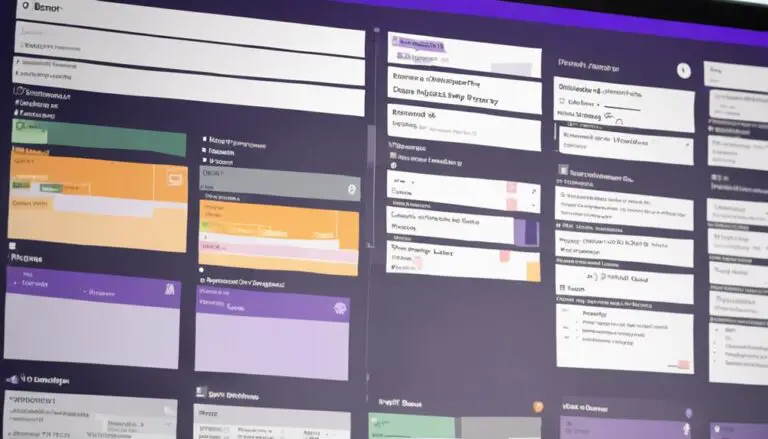To successfully incorporate sprints in Kanban, remember the adage 'slow and steady wins the race.'
By melding the structured approach of sprints with Kanban's visual workflow management, you can boost team collaboration and efficiency.
But how do you seamlessly blend these methodologies to maximize productivity and outcomes?
Let's explore practical strategies and expert insights to navigate the integration of sprints in Kanban successfully. By understanding the benefits and limitations of sprints in kanban, teams can tailor their approach to fit their unique needs. This may involve setting clear sprint goals, establishing a regular cadence for planning and review meetings, and integrating sprints into the overall flow of work in the kanban system. Additionally, seeking input from experienced practitioners and learning from real-world case studies can provide valuable insights into best practices for incorporating sprints in kanban.
Key Takeaways
- Define Sprint goals and length for focus and predictability.
- Utilize Kanban boards and flow metrics for tracking and improvement.
- Implement WIP limits and process policies for transparency and efficiency.
- Foster collaboration, feedback loops, and continuous learning for success.
Benefits of Combining Sprints and Kanban
By combining Sprints with Kanban, you enhance team collaboration and communication, fostering a more efficient workflow. In the dynamic world of software development, a blend of Scrum and Kanban methodologies can bring significant advantages to your team. Kanban's visual representation of tasks and Scrum's time-boxed approach complement each other seamlessly. Kanban allows you to visualize your workflow, identify bottlenecks, and continuously improve your processes. On the other hand, Scrum provides structure through Sprints, ensuring that work is delivered in manageable increments.
Integrating Sprints in Kanban not only streamlines task prioritization but also enables your team to adapt quickly to changes. The combination promotes transparency, as Kanban's boards make progress visible, while Sprint planning in Scrum ensures a focused and time-bound approach. This collaboration encourages team members to communicate effectively, align their efforts, and collectively work towards achieving the sprint goals. Ultimately, blending Sprints with Kanban empowers your team to deliver high-quality results consistently.
Implementing Sprints in Kanban Workflow
To successfully integrate Sprints into your Kanban workflow, implement time-bound iterations within your process to enhance team focus and predictability. Here are some steps to help you effectively implement Sprints in your Kanban workflow:
- Define Sprint length and goals: Establish clear timeframes and objectives for each Sprint to concentrate team efforts on specific tasks.
- Utilize Kanban boards: Visualize Sprint Backlogs, work in progress, and completed tasks on your Kanban board for better tracking and transparency.
- Conduct Sprint planning meetings: Gather team members to outline Sprint Backlog items, prioritize tasks, and ensure alignment on goals and expectations.
- Monitor Sprint progress: Use flow metrics such as cycle time and throughput to track performance and identify areas for improvement throughout the Sprint duration.
Strategies for Successful Sprint Integration
Incorporate WIP limits on your Kanban board to effectively control task flow and maintain focus on completing tasks within each Sprint. By setting limits on Work in Progress, you ensure that team members concentrate on finishing the work at hand before taking on new tasks, enhancing productivity in Sprint planning.
Utilize flow metrics such as cycle time and throughput to track team performance and identify areas for improvement in Sprint integration. Visualize work progress across columns on the Kanban board to monitor task movement and optimize workflow efficiency, aiding in successful Sprint planning with Kanban.
Additionally, make use of Kanban's explicit process policies to define work item movements, fostering collaboration and transparency within the team during Sprint integration. Create feedback loops through regular reviews and retrospectives to continuously enhance Sprint planning and Kanban workflow, promoting a culture of learning and improvement among team members.
Enhancing Productivity With Kanban Sprints
Enhance your team's productivity by integrating Kanban Sprints to focus on continuous delivery and optimizing workflow efficiency. By incorporating time-bound Sprints within the Kanban framework, you can achieve specific goals and milestones effectively.
Implementing WIP limits and visual management ensures tasks flow smoothly through the Sprint cycle, enhancing productivity. Leveraging Kanban Sprints not only improves efficiency but also aids in prioritizing work and meeting deadlines effectively.
Furthermore, by using Kanban Sprints for product backlog refinement, you can streamline your workflow and ensure that the most critical tasks are addressed promptly. Tracking flow metrics within Kanban Sprints allows for a more data-driven approach to decision-making, leading to better outcomes.
Lastly, fostering team collaboration through the utilization of Kanban Sprints promotes a culture of shared responsibility and collective achievement, driving your team towards success.
Best Practices for Sprint Incorporation
Consider setting clear Sprint goals and time frames within the Kanban system to drive focused delivery and enhance workflow efficiency. By defining specific objectives for each Sprint, teams can align their efforts towards achieving tangible outcomes. Additionally, utilizing Work In Progress (WIP) limits ensures that tasks are adequately managed within Sprints, preventing overburdening and optimizing flow efficiency.
Conducting regular Sprint planning sessions is crucial for prioritizing work items and maintaining alignment with Sprint goals. This practice facilitates the smooth progression of tasks and helps in adapting to changing priorities effectively. Monitoring Sprint progress through metrics like cycle time and throughput enables teams to identify bottlenecks and areas for improvement continuously.
Encouraging team collaboration and open communication is vital for enhancing Sprint success within the Kanban framework. Collaboratively working towards Sprint goals fosters a sense of shared responsibility and ownership, leading to increased productivity and overall satisfaction within the team. By following these best practices, teams can effectively incorporate Sprints into their Kanban workflow, driving efficiency and successful project delivery.
Key Insights for Kanban Sprint Fusion
Utilize flow-based Sprint Planning metrics in Kanban to optimize task management and enhance team performance during Sprints.
When merging Sprint Planning with Kanban boards, consider the following key insights:
- Visualize Progress: Use Kanban boards to track Sprint Backlog items, visualize progress, and identify bottlenecks efficiently.
- Implement WIP Limits: Control task flow by incorporating Work In Progress (WIP) limits on Kanban boards, enhancing team focus and productivity.
- Focus on Flow Metrics: Monitor metrics like WIP, cycle time, and throughput to improve efficiency and identify areas for process enhancement.
- Promote Collaboration: Integrate Sprint planning with Kanban methodology to foster collaboration, communication, and alignment within the team.
Tips for Seamless Sprint Integration
When integrating sprints into your Kanban system, remember to define clear sprint boundaries and use WIP limits to manage tasks effectively.
Implement Sprint Backlog items as top priorities and track progress using flow metrics for continuous improvement.
Regular Sprint Planning meetings will help you replenish tasks and align with sprint goals seamlessly.
Sprint Planning Tips
Start by setting clear Sprint goals and priorities to seamlessly integrate Sprint planning into your Kanban system. To enhance your Sprint planning process, consider the following tips:
- Establish Clear Objectives: Define specific goals and priorities for each Sprint to guide your team effectively.
- Utilize WIP Limits: Use Work In Progress limits on your Kanban board to manage the number of tasks in progress during a Sprint.
- Leverage Flow Metrics: Monitor cycle time and throughput metrics to track Sprint progress and identify areas for improvement.
- Encourage Team Collaboration: Foster open communication and collaboration among team members to ensure a smooth integration of Sprints within your Kanban workflow.
Sprint Review Process
To seamlessly integrate the Sprint Review process into your Kanban system, focus on gathering valuable feedback and insights from stakeholders on completed work items. During the Sprint Review, the emphasis lies on inspecting the increment, adapting the backlog, and determining next steps collaboratively. Stakeholders' participation is crucial as they provide feedback, ensuring alignment with business goals.
This feedback loop not only validates work completion but also aids in gathering input for backlog refinement and enhancing transparency within the team. The Sprint Review process in Kanban is designed for continuous improvement, driving iterative enhancements based on the feedback received.
Frequently Asked Questions
How Does Kanban Work With Sprints?
In Kanban, you work with Sprints by planning them effectively, fostering continuous improvement, and promoting team collaboration. Sprint planning sets clear goals, continuous improvement drives growth, and collaboration enhances productivity, creating a dynamic and cohesive workflow.
How Do I Manage Sprints in Kanban Board?
To manage sprints on a Kanban board, track your progress by moving tasks through stages like To Do, In Progress, and Done within the Sprint section. Plan your sprints, review your progress, and iterate for future optimization.
How to Do Sprints Effectively?
Start sprint planning with clear goals and timeframes. Execute tasks collaboratively, ensuring team accountability. Embrace continuous improvement through retrospectives for enhanced effectiveness. Remember, successful sprints in Kanban rely on teamwork and adaptability.
How Do You Implement Sprints?
To implement sprints successfully, start with sprint planning to prioritize tasks. Enhance team collaboration within the agile framework. Embrace an iterative approach for continuous improvement. Reflect on the process through retrospectives. Replenish tasks for a seamless flow.
Conclusion
As you reach the end of this journey on incorporating sprints in Kanban, remember that like a river flowing through the mountains, your team's workflow can be agile and adaptable. Embrace the merging of sprints and Kanban as a symbol of constant evolution and improvement.
Keep iterating, collaborating, and setting new goals to navigate the waters of productivity with ease. Together, you can achieve great things by seamlessly integrating sprints into your Kanban workflow.





